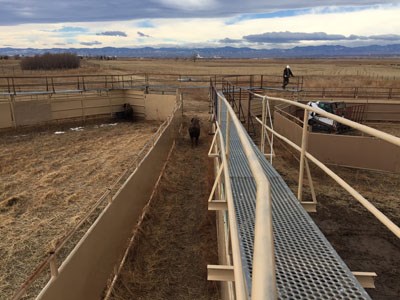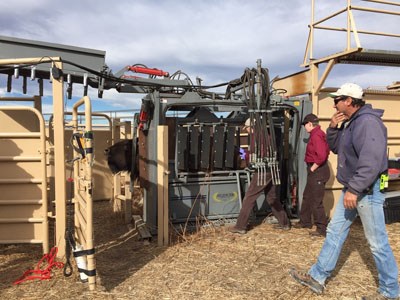Last updated: April 5, 2018
Article
Bison Bellows: Rocky Mountain Arsenal - from nerve gas to bison conservation

Photo courtesy of U.S. Fish and Wildlife Service
The Rocky Mountain Arsenal is not your typical National Wildlife Refuge. Seventy years ago, the United States Army used the land to produce mustard gas, incendiary weaponry, and dump chemical materials. Later, Shell Chemical Company started producing harmful insecticides and herbicides. And in 1987, it was declared as one of Earth's most polluted pieces of land! However, today it is home to bison, prairie dogs, and 330 other thriving wildlife species. The Rocky Mountain Arsenal, located ten minutes outside of downtown Denver, Colorado, offers one of the most unique urban wildlife refuges in the country.
Last week, on December 8, 2015, the Rocky Mountain Arsenal rounded up the bison herd to gather animals that had been selected for donation to the Crane Trust--a bison conservation organization--and for disease monitoring. For the US Fish and Wildlife Service and the staff who helped at the roundup, it was an exciting day filled with rambunctious calves, picture snapping, and sample taking. But for the bison, their experience was quite different.
Starting a week prior to the roundup, Rocky Mountain Arsenal managers slowly started to remove the bison's more distant water sources as a way to influence their movement towards alternative water sources in the grazing areas closer to the corral. This year, over half the herd moved on their own to a final area referred to as the "triangle."
On December 8th, once the equipment setup was complete and staff members attended the safety meeting, the roundup began right after sun up. Staff used pickup trucks to help encourage the bison's movement from the triangle to the "spin pen" and put them in groups of ten. While the spin pen may seem like the name of an amusement park ride, it is actually the first corral where the bison come to be moved by a skidsteer (a small, engine powered machine often used for construction) into the "circular maze" of the corral. The circular design allows the animals to move freely while reducing the chance of injury. The bison are then individually moved through the alley with holding stations, each with metal gates and doors. Staff members were reminded of the wildness of these animals as the banging and grunting of frustrated and nervous bison were heard throughout the day at the Arsenal.

Photo courtesy of U.S. Fish and Wildlife Service
Once each individual bison reached the "central hub," it was the ultimate deciding point: go free or go to the "squeeze chute." With a long pole, researchers gently placed a device next to each bison's head in order to read a microchip that was implanted in a previous roundup. All adults, except for the animals selected for donation, were scanned and then free to exit the hub and return to the Refuge. But if the bison was a calf or yearling that did not have a microchip or was a bison selected for donation, then off to the squeeze chute it went. The squeeze chute is a metal contraption that applies pressure to the bison when they are in it. It is reported that slight pressure on the animal's body calms it, and the hydraulic chute at the Arsenal is specially designed to limit the amount of pressure applied to prevent injury. In the chute, a variety of tasks can happen. Microchips are applied to the calves, blood is collected, biopsies are taken from a small number of animals for contaminants surveillance, and hair is pulled from the tail for genetic testing.
Finally, the ultimate decision of where the bison goes after being released from the squeeze chute is based on genetics. The Arsenal decides which bison they want to keep and which they want to remove from herd. If the bison is too genetically similar to the herd and is young, it is selected and moved to the adult or yearling pen to be donated. This year the Crane Trust located in Nebraska received 20 of these chosen bison in order to start a conservation herd of their own. If there are unique or less common genetics that can help the viability of the Rocky Mountain Arsenal herd, then it is free to go back to its herd. Age is important in the processing, because the younger animals transport better than the older bulls, and keeping older animals in the herd improves genetic diversity conservation. Safety is also imperative in the roundup process as well. "We are focused on bison safety here at the Arsenal," says US Fish and Wildlife Service wildlife biologist Lee Jones. "Our ultimate goal at the roundup is to make sure each animal does not hurt itself. We don't have to get every sample, but we do have to make sure every bison leaves without any injuries."
The Rocky Mountain Arsenal is a unique urban refuge that allows the growing Denver population to protect their Colorado natural resources and prairie ecosystem. The Refuge fosters a connection between urban and wild lands. To find out more information about the Refuge, visit their website here.
Did you know?
One main objective of the Rocky Mountain Arsenal is to restore prairie habitat by managing the composition and structure of native vegetation, a goal they can accomplish with grazing bison. Bison snip grasses lower to the root than livestock and other ungulates do, therefore helping to create a mosaic of different patches of vegetation. Their grazing affects not only the plant communities, but improves the habitats of grassland birds, increases soil nitrogen, and allows for long-term ecosystem health.
